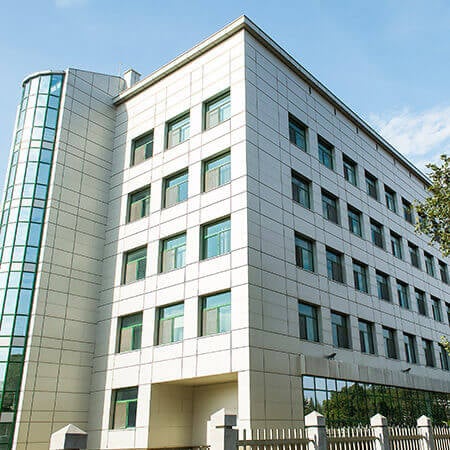Knee Arthritis III-IV Degree — Bilateral Total Knee Replacement: treatment in the Best Hospitals of Germany
Treatment prices are regulated by national law of the corresponding countries, but can also include additional hospital coefficients. In order to receive the individual cost calculation, please send us the request and medical records.
Joint Replacement in Germany
- Hip replacement
- Total knee replacement
- Shoulder joint replacement
- Total elbow replacement
- Hip replacement in neck fracture
- Total knee replacement and rehabilitation
- Hip replacement and rehabilitation
- Bilateral hip replacement
- Bilateral hip replacement and rehabilitation
- Bilateral total knee replacement and rehabilitation
- Orthopedic rehabilitation

Department of Adult and Pediatric Orthopedics, Trauma Surgery, Foot Surgery, Hand Surgery and Rheumatology
The Department of Adult and Pediatric Orthopedics, Trauma Surgery, Foot Surgery, Hand Surgery and Rheumatology offers the full range of diagnostic and therapeutic services in its areas of specialization. The key areas of work of the department's doctors include large joint arthroplasty, arthroscopic interventions on the knee, hip, and shoulder joints, conservative and surgical treatment of foot and hand diseases and deformities, rheumatic joint lesions, orthopedic diseases in children, and musculoskeletal injuries. The key to successful clinical practice is the professionalism and unique experience of the department's medical team, combined with the advanced infrastructure and state-of-the-art equipment. The department has 5 operating rooms equipped with the latest technology. Most surgical interventions are performed using minimally invasive techniques, due to which, in the shortest possible time, the patient is verticalized, their mobility is restored, and a pronounced pain syndrome is excluded. The department annually performs more than 4,500 surgical interventions, including especially complex ones, so the specialists at the medical facility are rightfully proud of their impressive clinical experience in the surgical treatment of orthopedic diseases. Over the years, the department has gained an excellent reputation not only in Germany but also far beyond its borders.





Department of Adult and Pediatric Orthopedics, Trauma Surgery and Arthroplasty
The Department of Adult and Pediatric Orthopedics, Trauma Surgery and Arthroplasty provides the full range of medical services in the areas of its competence. The department's team of doctors treats patients with diseases and injuries of the musculoskeletal system, joints, bones, tendons, ligaments, and muscles. Orthopedists specialize in partial and total knee, hip, and shoulder replacement surgery, as well as successfully perform revision arthroplasty. Doctors perform arthroplasty at the EndoCert certified Maximum Care Center for Joint Replacement Surgery. The department also has the status of a regional Trauma Center Berlin-Brandenburg, where both common household injuries and severe multiple injuries are effectively treated. The department's team of doctors has a perfect command of advanced conservative and surgical treatment methods in the area of its specialization. Joint replacement surgery is performed here using minimally invasive techniques, which allows the patient to get back on their feet and get rid of pain as quickly as possible. The department has also gained vast experience in arthroscopic treatment of pathologies of large joints and injuries of the tendons, ligaments, and muscles. The department uses an innovative method of cartilage tissue restoration called autologous chondrocyte implantation. Patients of the medical facility receive personalized medical care in comfortable conditions.




Department of Trauma Surgery, Orthopedic Surgery and Foot Surgery
The Department of Trauma Surgery, Orthopedic Surgery and Foot Surgery offers the full range of modern diagnostic tests for the detection of musculoskeletal diseases, as well as many effective treatment methods for their elimination. Moreover, the department enjoys the status of the Center of Excellence for Trauma Surgery, so trauma surgeons working in the medical facility have a rich and unique experience in the treatment of patients after both simple common and especially complex injuries, including traumatic brain injuries, spinal injuries, polytrauma, injuries of the internal organs, etc. In addition to the treatment of injuries, a special focus is on arthroscopic interventions, joint replacement surgery, interventions to treat foot diseases and deformities, as well as surgery to resect soft tissue tumors. The surgical treatment is provided in the high-tech operating rooms with advanced surgical instruments and computerized systems for the most effective interventions with minimal damage to the healthy adjacent tissues.




Gonarthrosis is one of the most common pathologies in the world. Due to the high average life expectancy of the population, its prevalence in developed countries reaches 20%. This is the second most common orthopedic disease after coxarthrosis. It is more difficult to treat, replacement surgery is technically more complex, and unfavorable functional outcomes are more common. In addition, in many patients, arthrosis affects both knees at once, so two endoprostheses have to be implanted.
To have high-quality surgery with minimal risk to health, it is better to undergo treatment in Germany. This country has a high level of medicine. Even the most complex surgical interventions are successfully performed here. Artificial knee joints are implanted using computer-assisted navigation, which reduces the risk of endoprosthesis loosening by 8 times. If necessary, doctors replace both knees at once within a single surgical procedure.
Content
- Why should two knee joints be replaced?
- Indications for bilateral knee replacement
- Options of bilateral replacement surgery
- Benefits of single-stage bilateral knee replacement
- Benefits of two-stage bilateral knee replacement
- Functional outcomes of bilateral replacement surgery
- How is the surgery performed?
- What endoprostheses can be used?
- Postoperative period
- Treatment in Germany with Booking Health
Why should two knee joints be replaced?
Osteoarthritis is a disease that develops due to joint weakness and excessive stress on them.
As a rule, both groups of risk factors affect two joints at once. Exceptions are cases of traumatic injury, inflammation or extreme stress on one leg in some sports. Most cases of gonarthrosis develop due to a hereditary predisposition, obesity, and hard physical labor. Patients usually have both joints affected, although one of them is in better condition at the time of diagnosis.
Approximately 20% of patients suffering from gonarthrosis have pathological changes in the second joint of at least grade 2. They are candidates for bilateral knee replacement.
Indications for bilateral knee replacement
An absolute indication for bilateral total knee replacement is the development of bilateral arthrosis, if the damage to both joints corresponds to grade 3-4. In this case, other treatment options simply do not exist, with the exception of those that leave the person disabled. Only bilateral knee replacement helps to simultaneously restore the function of the lower extremities and get rid of chronic pain syndrome.
Doctors may recommend bilateral knee replacement even if grade 3-4 arthrosis is detected on only one limb, and grade 2 on the other. This is due to the fact that the disease inevitably progresses in the future. Moreover, in the recovery period after surgery to replace one joint, there is a very rapid development of osteoarthritis. It is caused by increasing stress on the knee. The person cannot lean on the recently operated leg. As a result, the entire body weight is transferred to the other leg, and the knee joint quickly wears out.
The maximum rate of progression of arthrosis on the second limb is observed during the first three months after unilateral replacement surgery. During this period, arthrosis can develop from 2 to 3 grades.
Bilateral total knee replacement is substitution of both knee joints with prostheses in people with bilateral knee arthritis.
Cost of the bilateral total knee replacement surgery starts from €28,700. You can find prices for other treatment options in knee arthritis on the Booking Health website.
The best hospitals in Germany for bilateral knee replacement are:
- Vitos Orthopedic Clinic Kassel
- Hospital Kassel
- Academic Hospital DRK Berlin Westend
- St. Antonius Hospital Eschweiler
Options of bilateral replacement surgery
Bilateral knee replacement can be either single-stage or two-stage.
A single-stage bilateral knee replacement involves performing one surgical procedure, during which a team of surgeons sequentially implants prostheses on both limbs. This surgery takes longer and it is more traumatic, but it reduces overall financial costs and time spent on treatment.
A two-stage knee replacement requires a break between the two surgical procedures. It can be different. In most cases, a break is made for 3-6 months. After 3 months, complete restoration of bone structures occurs, and after 6 months, the function of the limb is completely restored. In some cases, the intervals can be longer (up to 12 months) or less (only 2-3 weeks).
Benefits of single-stage bilateral knee replacement
Total knee replacement on both sides is a longer and more complicated operation. But for many patients, it seems attractive because it has many benefits:
- Only one surgery. It is easier to decide on one surgical intervention than two. A person only needs to prepare, undergo diagnostic tests prior to surgery, and have anesthesia just once. The hospital stay is also only one, although it is longer than after replacing only one knee joint.
- Reduced recovery period. Only once, but not twice, one needs to go through a long stage of rehabilitation. It lasts at least 3-4 months. With a two-stage approach, this time interval would have to be multiplied by two.
- The goal of the treatment is achieved sooner. The main goal of replacement surgery is to enable a person to return to an active life, relieve pain, and fully restore the function of the lower extremities. With the single-stage treatment, these goals are achieved within 4-6 months, and with two-stage treatment – at least 3 months later.
- The cost of treatment is 30% lower. Although the patient still needs to buy 2 artificial joints, and the surgery to implant them at one time will cost more than a standard intervention, the cost will ultimately be lower than with the two-stage approach. In any case, one surgical procedure is cheaper than two. In addition, the costs of diagnostics and rehabilitation are reduced as well.
Benefits of two-stage bilateral knee replacement
The most common approach to bilateral knee replacement involves performing two surgical procedures with a break for several months. The benefits of this approach are:
- Less health risks. The single-stage knee replacement is more traumatic. A person is under anesthesia longer and loses more blood. In elderly patients with severe internal diseases, preference is given to a two-stage intervention.
- The early rehabilitation period is more difficult. The volume of tissues damaged during the surgery is greater, there are difficulties with the early activation of the patient. There is no healthy leg to lean on when walking. However, it is almost impossible to call a leg with 3-4 arthrosis grade healthy. In many patients, the second leg is close to the operated limb in terms of its functionality.
- Lower one-time costs. Although the total cost of the treatment is higher, the patient pays for the services of the doctors and purchases the artificial joints gradually. He has several months to save money for the second surgery.
Functional outcomes of bilateral replacement surgery
In the same way as with unilateral joint replacement, successful bilateral surgery can completely restore the function of the limb and permanently relieve the patient of chronic pain.
Several studies demonstrate the advantages of single-stage replacement surgery over two-stage one in functional outcomes. They are as follows:
- Better range of motion in the knee.
- Less risk of pain, and if it persists, it is less pronounced.
- The need to use a cane is less frequent.
- Patients return to work more often and their level of physical activity is higher.
- Polls show that patients are more likely to be satisfied with the functional outcomes of the single-stage operations.
The main reasons for better functional outcomes after the single-stage knee replacement are:
- Less duration of pain. After the operation, the leg hurts, but after a few weeks the pain disappears. Without surgery, the leg hurts constantly, and the pain does not disappear. This makes rehabilitation difficult with a two-stage approach. A person cannot fully exercise and cannot restore a normal walking pattern, since arthrosis of the second knee has not yet been cured.
- No progression of arthrosis. After replacing the knee on the other leg, arthrosis progresses much faster. The rate of progression is maximum in the first 3 months after the intervention, as the load on the unoperated limb increases.The problem is that the more severe the arthrosis, the worse the functional outcomes of knee replacement surgery. At the time of the second surgery, the joint may be more damaged, so the results of treatment are worse.
- Possibility to use a different type of prosthesis. For grade 3 arthrosis, doctors try to use unconstrained mobile-bearing prostheses. They provide the best indicators of limb functionality. In addition, such prostheses wear out much more slowly – they can last for decades. However, with grade 4 arthrosis, it is often necessary to resort to the implantation of constrained prostheses, which have less mobility and wear out faster.
How is the surgery performed?
Bilateral knee replacement surgery is performed under general or spinal anesthesia. The surgical intervention takes 3-4 hours. The doctor removes the cartilage and bone structures in the knee area and implants the components of the artificial joint.
In Germany, the operation is performed with the use of computer-assisted navigation. It ensures perfectly accurate placement of the endoprosthesis components. Tilt angles are controlled with an accuracy of 0.1 degrees, and distances with an accuracy of 0.1 mm.
The benefits of computer-assisted navigation have been proven many times in clinical trials. For knee replacement, accuracy is more important than for any other. With the slightest error, if the biomechanical axis of the lower limb deviates by 4 degrees or more, the risk of loosening of the endoprosthesis within 8 years reaches 25%. In the event of loosening, the function of the limb is impaired, and therefore it is necessary to perform revision (repeated) replacement surgery. Moreover, revision prostheses, as a rule, are less functional and wear out faster.
Without computer-assisted navigation, in 60% of cases, the limb axis is deflected by 4 degrees or more. But when the artificial joint is implanted with the use of computer-assisted navigation, in 100% of cases the deviation does not exceed 3 degrees, and in most patients it is only 1-2 degrees. As a result, the artificial joint lasts much longer. The risk of aseptic loosening within 8 years is only 3%. Only 10% of cases will require the second surgery to replace the endoprosthesis.
What endoprostheses can be used?
For knee replacement, three groups of total (three-pole) endoprostheses can be used:
- Unconstrained.
- Partially constrained.
- Fully constrained.
Unconstrained endoprostheses provide better functional outcomes and wear more slowly. An important condition: the patient's own ligaments preserved, knee stability, and the normal axis of the lower limb.
Partially constrained prostheses are used if the ligaments are damaged. There are options for endoprostheses that replace or preserve the posterior cruciate ligament. Its preservation is preferable. A large study by M. Abdel with the participation of more than 8,000 patients showed that if the cruciate ligament is preserved, then the survival rate of the prosthesis within 15 years is 90%, and if this ligament is replaced, then this indicator is lower – only 77%.
In the most severe cases, for example, with bone tissue deficiency or repeated replacement surgery, fully constrained prostheses are used. They replace the knee along with all its ligaments.
Constrained prostheses can be rotating hinge and pure hinge ones. A different type of fixation is used less often. The rotating hinge prostheses are used more often, as they are more functional. While the pure hinge ones only provide flexion and extension of the knee, the rotating hinge ones also retain the ability to rotate the lower leg.
Although fully constrained prostheses provide a good functional effect even in the most advanced forms of arthrosis, they wear out much faster than unconstrained and partially constrained ones.
Postoperative period
Postoperative patients receive therapy to relieve pain and prevent complications. Antibiotics are prescribed to avoid infections. Anticoagulants are used to prevent thromboembolism.
The patient is activated as early as possible after the surgery. The early rehabilitation period can be somewhat more difficult after the single-stage surgery compared to the two-stage replacement. However, if we evaluate rehabilitation as a whole, taking into account the late phase, then it is much easier for a person to recover after replacing two joints at once. This is due to the fact that the pain does not interfere with training, both knees are mobile, the limbs are no longer deformed, one can immediately form the correct walking stereotype.
According to N.R. Bao, who in his study reports the results of the single-stage bilateral knee replacement in 72 patients, only 2 weeks are required to achieve good mobility. An important condition is appropriate rehabilitation measures, as well as high-quality preparation in the preoperative period.
Treatment in Germany with Booking Health
To undergo bilateral knee replacement surgery in one of the best hospitals in Germany, please use the Booking Health services. On our website, you can find out the cost of treatment in different German hospitals, compare prices and book a medical care program at an affordable price.
Please contact the Booking Health specialists to undergo treatment in Germany. Here are our benefits for you:
- We will choose the best hospital whose doctors specialize in bilateral total knee.
- We will help you overcome the language barrier, establish communication with the German hospital and your attending physician.
- We will reduce the waiting time for the start of the medical care program and book a doctor's appointment on the most suitable dates.
- We will reduce the price. The cost of treatment in Germany will be decreased due to the lack of additional coefficients for foreign patients.
- We will take care of all organizational issues: documents for entering the country, transfer from the airport, hotel, interpreter, etc.
- We will prepare a medical care program and translate medical documents into German. You do not have to repeat previously performed diagnostic procedures.
- We will provide communication with the hospital after the completion of treatment in Germany.
- We will organize additional medical examinations, treatment in Germany or rehabilitation, if necessary.
- We will buy medicines in Germany and forward them to your native country.
- We will help you keep in touch with the hospital after treatment in Germany.
Booking Health makes treatment in Germany easier, faster and cheaper. We will fully organize your trip, and you will only have to focus on restoring your health.
Authors: Dr. Vadim Zhiliuk, Dr. Sergey Pashchenko

